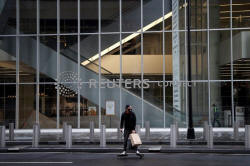U.S. Fed's Main Street lending facility likely to start
with a whimper
 Send a link to a friend
Send a link to a friend
 [June 08, 2020] By
Jonnelle Marte and Michelle Price [June 08, 2020] By
Jonnelle Marte and Michelle Price
(Reuters) - The Federal Reserve's most
ambitious and complicated crisis relief program is set to launch in
coming days but it is far from certain that the small and mid-sized
businesses the $600 billion "Main Street Lending Facility" is meant to
help will come clamoring for loans.
Two months into the economic crisis spurred by the novel coronavirus
pandemic, some lobbyists, bankers and small business consultants say the
loans may be too large to help many struggling businesses and some
borrowers are worried about coming under public scrutiny.
Some lenders also say they are concerned about the balance sheet risks
they could face by participating.
"From our lenders, I'm seeing very limited interest because of the large
minimum loan size of a half million," said Paul Merski, an executive
vice president at the Independent Community Bankers of America.

The program aims to provide credit to businesses that are too large for
the Paycheck Protection Program, which targets companies with fewer than
500 employees, and too small to directly benefit from the Fed's
corporate bond buying programs.
As with the PPP, the Main Street facility loans will be distributed via
participating banks, but unlike the PPP those loans are not forgivable
and will have to be repaid.
The program, which is being administered by the Federal Reserve Bank of
Boston, will lend to U.S. businesses with up to 15,000 employees or
revenues capped at $5 billion. Loans can range in size from $500,000 to
$200 million. Borrowers have four years to repay the loans, with no
payments due the first year and no penalty on prepayment.
The Main Street program is part of the federal government's
unprecedented effort to shore-up the U.S. economy and help companies
retain workers after the coronavirus shutdown put more than 20 million
Americans out of work.
Data from the 2017 Census business survey suggests more than 38,000
companies employing about 30.2 million people could make use of the
program, including more than half of the S&P 500.
"It is far and away the biggest challenge of any of the 11 facilities
that we've set up," Fed chair Jerome Powell said last month during a
Princeton University webcast in which he also said the central bank is
open to adjusting the program.
UNWELCOME SCRUTINY
With Congress ramping up scrutiny of bailout funds, the Main Street
program has already attracted controversy. In April, lawmakers accused
the Fed of bowing to the oil and gas lobby after the central bank
changed the facility's terms to better accommodate highly indebted
industries.
[to top of second column] |

A man rides a motorized skateboard on a nearly deserted Church
Street in the financial district of lower Manhattan during the
outbreak of the coronavirus disease (COVID-19) in New York City, New
York, U.S., April 3, 2020. REUTERS/Mike Segar

Since then, many companies have grown wary of the scrutiny that comes with
tapping federal aid, especially after many publicly-listed companies were widely
criticized for taking PPP loans, according to bankers and lobbyists.
The Fed plans to publish the names of lenders and borrowers, the amounts
borrowed and interest rates charged, along with other details.
"There's the potential for future scrutiny with hindsight that we don't have
today," said Matt Kulkin, co-chair of the financial services group at Steptoe &
Johnson.
He added that some businesses may also hold off from applying until they get
clarity on the conditions the Fed will impose on borrowers, in particular a
requirement that companies make "a reasonable effort" to retain workers.
Other limits on executive compensation, dividends or stock buybacks will also
put some companies off, said Kulkin.
LOAN SIZES TOO LARGE
The Fed expanded the program in April after receiving more than 2,200 comment
letters by lowering the minimum loan amount to $500,000 from $1 million and by
raising the cap on employees and revenue. But some small banks say they are
likely to sit the program out because its loan sizes are still too large.
The ICBA and American Bankers Association had pushed for the minimum loan size
to be no more than $100,000.
"I still don't understand why a minimum is even needed," tweeted Jill Castilla,
President and CEO of Citizens Bank of Edmond in Oklahoma last month regarding
the facility.
Large and small banks are also worried about the risks they could face. The Fed
will purchase 85% or 95% of qualifying loans, depending on the type, and the
bank will keep the rest of the loan on its balance sheet.
Because they are taking on some of the risk, banks can set their own
underwriting standards but even holding 5%-15% of a loan in a troubled business
may be too much, said bankers and lobbyists.

"It may be something that the largest banks and businesses will take up but
really the loan terms may need to be adjusted for a more robust participation,"
said Merski.
(Reporting by Jonnelle Marte and Michelle Price; Additional reporting by Howard
Schneider; Editing by Dan Burns and Andrea Ricci)
[© 2020 Thomson Reuters. All rights
reserved.] Copyright 2020 Reuters. All rights reserved. This material may not be published,
broadcast, rewritten or redistributed.
Thompson Reuters is solely responsible for this content. |